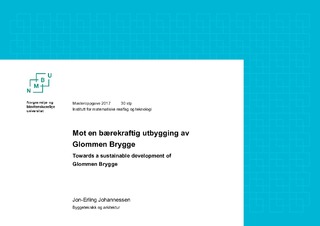| dc.description.abstract | Byene har gjennom de siste århundrene gjennomgått en syklisk transformasjon. Fra en kraftig vekst og fortetting via industrialismen, til en fortynningspolitikk gjennom den moderne byplanleggingen, og i dag tilbake til en fortettingsstrategi. Dagens visjon om en mer kompakt by gjør at en ikke kan utvikle helt nye bymodeller, men må finne sunne måter å utnytte sentrumsarealer som allerede er bebygd og i bruk. Blant flere postindustrielle sentrumsområder som i dag står ovenfor en transformasjon, er de mange skipsverftene. Verftsområdene med sin unike beliggenhet anses som svært attraktive, og utviklings- og fortettingspotensialet er stort. Med en stadig økende tilflytting til byene og en økt etterspørsel i sentrale byboliger, utpeker verftsområdene seg som et viktig satsingsområde.
Sterk urbanisering, økt tetthet, utbyggingspress, omstilling til lavutslippssamfunnet, klimaendringer, ny teknologi, press på bokvalitet og tilgjengelighet for alle, er kun noen av utfordringer dagens myndigheter og byggenæring stilles ovenfor. De mange utfordringene søkes løst via en bærekraftig utvikling, et bredt og visjonært begrep forankret i vår lovgivning.
Oppgaven tar for seg å undersøke noen bevisste grep mot en bærekraftig utbygging av det tidligere skipsverftet Glommen Brygge. Tematikken besvares gjennom en målrettet prosess og et konkret prosjekteringsforslag for tomten. Oppgaven ønsker å fremme miljøvennlig og sosial bæredyktighet i arkitekturen, fremfor økonomisk gevinst som mål på suksess. Dette innebærer en forståelse av hvordan arkitektur påvirker mennesket og miljø. I oppgaven rettes den sosiale bæredyktigheten mot temaet bokvalitet. Den miljøvennlige bæredyktigheten rettes mot massivtre, og søker en bedre forståelse for mulig utnyttelse av materialet i urbane boligblokker.
Temaene bokvalitet og massivtre belyses gjennom en begrenset litteraturstudie. Deretter utføres det undersøkelser av områdets utvikling, tidligere foreslåtte utviklingsplaner og dagens reguleringsplan. Videre utføres det overordnede områdeanalyser, tomteanalyser, volumstudier og studier av leilighetenes mulige indre oppdeling. Med bakgrunn i litteraturstudiet og opparbeidet kunnskap om tomten, prosjekteres det tre nye boligblokker oppført i massivtre. Løsningen presenteres gjennom tydelige tegninger, detaljerte beskrivelser og bruk av fysiske modeller.
Oppgaven viser at Glommen Brygge er et attraktivt planområde med flere gode kvaliteter og et stort utviklingspotensial. Ved å fremme viktige kvaliteter ved bolig og boligområdet, samt ta hensyn til og forsterke tomtens iboende egenskaper, kan en oppnå gode kvaliteter i en mer kompakt by. Mulighetsstudiet viser at det er mulig å fortette området med boliger og samtidig beholde og utvikle kvaliteter for både boligeiere og bydelen. Oppgaven illustrerer også hvordan en potensielt kan utnytte massivtre i boligblokker. Det er rimelig å anta at massivtre benyttet i boligblokker, i tett bystruktur, kan gi et positivt bidrag i møte med dagens klima- og miljøutfordringer. Løsningsforslaget presenterer en mer effektiv og bærekraftig utnyttelse av området sammenliknet med nåværende situasjon og gjeldende reguleringsplan.
Over the past few centuries, cities have undergone a cyclical transformation. From powerful growth and densification by way of industrialisation, to a politics of dispersal through modern city planning, and back again to a strategy of densification today. The modern vision of a more compact city prevents one from developing completely new city models, instead requiring the discovery of healthier ways to utilise downtown areas that have already been developed, and that are already in use. Among a variety of post-industrial downtown areas that today stand before such transformations, we find the shipyards. With their unique locations, shipyard areas are considered to be highly attractive, and feature significant potential for development and densification. With a steadily increasing population flow to the cities and a heightened demand for central urban residences, the shipyard areas stand out as a key area of focus.
Major urbanisation, increased density, pressure to develop, restructuring for a low-emission society, climate change, new technology, residential quality pressures and universal accessibility are just some of the challenges faced by both public authorities and the construction industry in the modern day. A solution to these challenges is sought in sustainable development, a wide and visionary expression anchored in our legislation.
This thesis seeks to examine a few conscious efforts towards sustainable development of the former shipyard Glommen Brygge. This thematic challenge is met through a targeted process and a concrete design proposal for the property. The thesis aims to promote eco-friendly and socially sustainable architecture rather than financial profit as a measure of success. This requires an understanding of how architecture affects both people and the environment. Social sustainability is thus examined with regard to residential quality. Environmental sustainability entails the search for a greater understanding of the possible application of solid wood in urban housing blocks.
The issues of residential quality and solid wood are explored through a limited literature study. This is followed by examinations of the development of the area, development plans that have previously been proposed, and the current regulatory plan for the area. Following this, greater area analyses, property analyses, volume studies and studies of the possible interior division of the apartments are explored as well. With a foundation in the literature study and knowledge collected on the property, the thesis proposes three new housing blocks built from solid wood. The solution is presented in clear drawings, detailed descriptions, and through the use of physical models.
The thesis shows that Glommen Brygge is an attractive area with several excellent qualities and significant potential for development. By presenting the essential qualities of both housing and the residential area, while considering and reinforcing the inherent properties of the location, superior qualities can be attained in a more compact city. The feasibility study shows that it is possible to densify the area with residences while maintaining and developing qualities for both residents, and for the district. The thesis also illustrates how solid wood can potentially be applied in housing blocks. It is reasonable to assume that solid wood used in housing blocks, in dense city structures, can provide a positive contribution in its encounter with the environmental and climate-related challenges of the modern day. The proposed solution presents a more efficient and sustainable utilisation of the area compared with the current situation, and its existing regulatory plan. | nb_NO |

